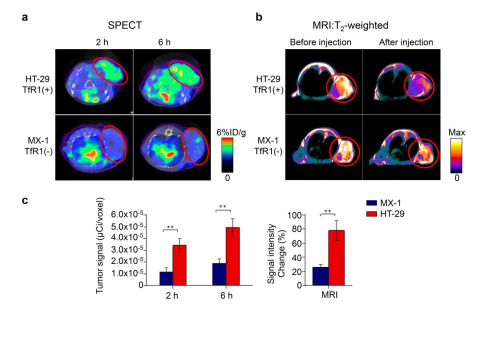H-ferritin for tumor SPECT/MR imaging
ACS Nano recently published a paper entitled “Bioengineered magnetoferritin nanoprobes for single-dose nuclear-magnetic resonance tumor imaging ” made by Professor Xiyun Yan’s research group at the Institute of Biophysics, Chinese Academy of Science. This is a breakthough followed up their finding of nanozyme (Nature Nanotechnol. 2007) and its application for tumor diagnosis (Nature Nanotechnol. 2012) and drug delivery (PNAS 2014).
Despite all the advances in multimodal imaging, it remains a significant challenge to acquire both magnetic resonance and nuclear imaging in a single dose because of the enormous difference in sensitivity. Indeed, nuclear imaging is almost 106-fold more sensitive than magnetic resonance imaging (MRI); thus, repeated injections are generally required to obtain sufficient MR signals after nuclear imaging. Here, we show that strategically engineered magnetoferritin nanoprobes can image tumors with high sensitivity and specificity using SPECT and MRI in living mice after a single intravenous injection. The magnetoferritin nanoprobes composed of 125I radionuclide-conjugated human H-ferritin iron nanocages (125I-M-HFn) internalize robustly into cancer cells via a novel tumor-specific HFn-TfR1 pathway. In particular, the endocytic recycling characteristic of TfR1 transporters solves the nuclear signal blocking issue caused by the high dose nanoprobes injected for MRI, thus enabling simultaneous functional and morphological tumor imaging without reliance on multi-injections.
The paper was published in ACS Nano (2016,

Figure 1. In vivo SPECT-MRI tumor imaging in living mice using 125I-M-HFn NPs. Tumor images (red circles) were obtained using (A) SPECT at 2 h and 6 h postinjection and (B) T2-weighted MRI at 6 h postinjection. (C) Quantitative analysis of TfR1(+) and TfR1(?) tumor images obtained from SPECT and MRI images.
CONTACT:
YAN Xiyun
Institute of Biophysics, Chinese Academy of Sciences
Beijing 100101, China
Phone: 86-10-64888583
Email: yanxy@ibp.ac.cn

